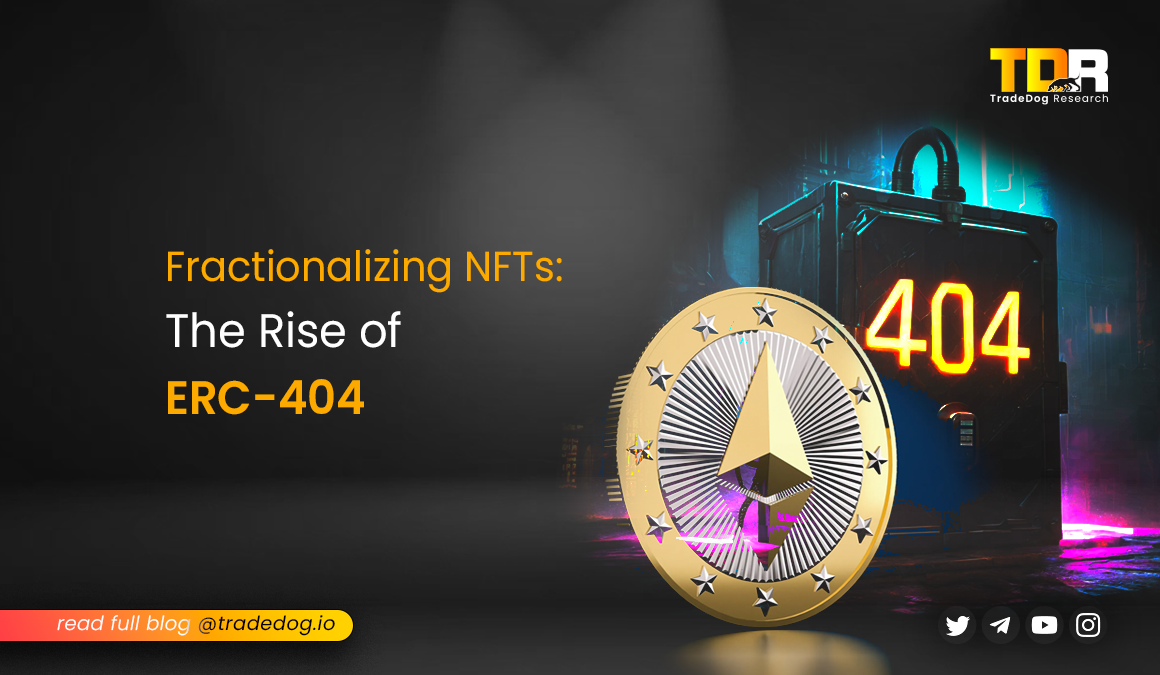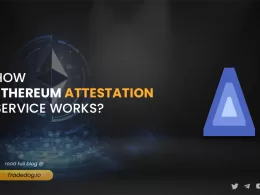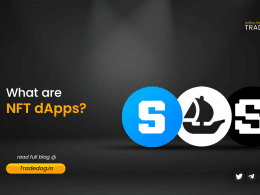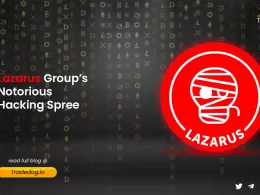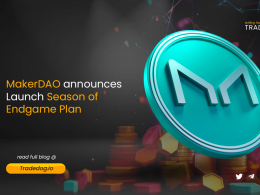Quick Links
The cryptocurrency market is constantly evolving, and with it comes a wave of innovative token standards. ERC-404 is one such standard with a market cap of ~$60 Mn and an overall DEX trading volume of over ~$1.8 Bn making waves for its unique ability to fractionalize NFTs, opening the door to exciting new possibilities in the blockchain. Developed by anonymous creators “ctrl” and “Acme,” ERC-404 bypasses the standard approval process, aiming for faster creation of NFTs with “native fractionalization, liquidity, and features that encourage trading and engagement”. Pandora, which has an MCap of ~ $46 Mn, became the first to leverage this standard, and the ERC-404 team is actively working on a formal Ethereum Improvement Proposal (EIP) for wider recognition.
Understanding ERC-404s
ERC-404s introduce a revolutionary concept: divisible NFTs. Unlike traditional NFTs (ERC-721) that are indivisible and owned by a single wallet, ERC-404 allows a single NFT to be divided into multiple ownership units.
ERC-404 merges elements of ERC-20 (fungible tokens) and ERC-721 (NFTs) to create “semi-fungible” assets. Developers can create and distribute fractionalized NFT collections for open trading and integration into various applications. This fractionalization is achieved through a locking mechanism: the original NFT is locked, and representative tokens reflecting its value are minted. These fractions can be freely traded, while the original NFT is burned if a single wallet acquires a majority, effectively recreating the whole NFT.
ERC-404 integrates seamlessly with existing Ethereum wallets and applications due to its compatibility with ERC-20 and ERC-721. Here’s a quick comparison highlighting its key features:
- EIP: Unlike ERC-20 (EIP-20) and ERC-721 (EIP-721), ERC-404 currently lacks a formal EIP.
- Asset Class: ERC-404 represents fractionalized digital assets, whereas ERC-20 stands for fungible digital assets, and ERC-721 for unique digital assets.
- Token IDs: ERC-404, similar to ERC-20, does not have unique token IDs, while ERC-721 assigns a unique ID to each asset.
Benefits of ERC-404
- Increased Liquidity: By enabling fractional ownership, ERC-404s alleviate the liquidity challenges often associated with NFTs. This broader investor participation can potentially boost project valuations.
- Easier Entry and Exit: Dollar-cost averaging becomes possible with ERC-404s. Users can gradually acquire fractions of NFTs, lowering the entry barrier compared to requiring a large upfront investment.
- Enhanced Trading: ERC-404s streamline trading for both coins and NFTs. Users can trade ERC-404 tokens on exchanges, eliminating the need for specific NFT marketplaces.
- Bridging DeFi and NFTs: ERC-404s foster a connection between Decentralized Finance (DeFi) and NFTs. Projects like Floor Labs have demonstrated the potential for tokenizing NFTs, allowing users to trade these fractionalized representations on decentralized exchanges. This unlocks entirely new possibilities for leveraging NFTs in DeFi applications like lending and borrowing.
- Unlocking New Use Cases: The ability to fragment ownership opens doors to innovative use cases. Imagine co-owning a rare digital artwork or collectible with friends, or using fractions of an in-game item as collateral for a loan within a play-to-earn game. ERC-404 paves the way for such possibilities.
ERC-404 Token Landscape
ERC-404, the innovative standard for fractionalized NFTs, is still in its early stages of adoption, but the initial signs are promising. While it pales in comparison to the overall Ethereum NFT market, ERC-404 has generated a respectable amount of activity in its short lifespan.
A closer look at the numbers:
Total Volume: As of Writing, the total trading volume for ERC-404 tokens sits at ~$1.88 Bn which is ~2.8% of the total trading volume of NFTs on Ethereum ~$64Bn.
Market Share: Compared to Ethereum’s last month’s NFT volume of ~$514 million, ERC-404 with ~$57 million represents 11% of the overall market.
Weekly Fluctuations: The weekly volume for ERC-404 is currently around $3.6 million, compared to Ethereum’s $153.90 million – indicating a less mature market with room for growth.
Number of Holders: There are currently around 1,150 ERC-404 token holders, showcasing a limited user base.
Token Count: There are currently 756 ERC-404 tokens in circulation, representing a limited number of projects utilizing the standard.
One project, Pandora, stands out as a pioneer in ERC-404 adoption. Launched in February 2024, it was the first to leverage this standard. Notably, Pandora generated a staggering $180 million in sales during Q1 of 2024, accounting for 12.8% of Ethereum’s NFT sales volume in that quarter. While other ERC-404 projects like DeFrogs and Alphabet show some traction, the overall adoption rate remains modest compared to established NFT standards. However, the innovative capabilities of ERC-404 and the success stories like Pandora’s point towards a promising future.
Use Cases
ERC-404 opens doors to innovative applications across various industries:
- Tokenization of Real-World Assets: like fractional ownership of real estate, art, and luxury goods becomes a reality, injecting liquidity into traditionally illiquid markets.
- Revolutionizing DeFi: Lending, borrowing, and yield farming can leverage ERC-404 to introduce new asset classes as collateral. Users can unlock portfolio value through fractionalized NFTs.
- Transforming Gaming and NFTs: In-game asset ownership, transferability, and interoperability reach new heights. Developers can fractionalize in-game items, fostering innovative gameplay and virtual economies. Players can co-own rare items or participate in virtual land ownership.
- Enhancing Supply Chain Management: Transparency and efficiency are improved. ERC-404 simplifies the issuance of unique IDs (fractionalized tokens) for various supplies, enabling traceability of product origins.
- Fractionalized DAOs: ERC-404 can be used to create fractionalized governance tokens for Decentralized Autonomous Organizations (DAOs). This allows for wider participation and lower barriers to entry for individuals interested in contributing to a DAO’s governance.
- NFT Collateralization for Traditional Finance: Fractionalized NFTs with ERC-404 can potentially be used as collateral for loans in traditional financial institutions. This could unlock liquidity for NFT holders and open doors for broader NFT adoption.
Challenges and Considerations
While ERC-404 presents a promising future for fractionalized NFTs, it’s important to acknowledge some potential roadblocks:
Developer Adoption: Widespread adoption by developers is crucial for ERC-404’s success. It will be essential to educate developers on the standard’s functionalities and build a strong community around it. This can involve creating developer resources, and tutorials, and fostering collaboration between projects utilizing ERC-404.
Technical Integrations: Ensuring seamless compatibility with existing blockchain networks and applications requires ongoing technical upgrades. This includes maintaining interoperability with popular wallets, NFT marketplaces, and DeFi protocols. Developers working with ERC-404 must stay updated on these integrations to guarantee smooth user experiences.
Security Concerns: As with any new technology, potential security vulnerabilities need thorough analysis and mitigation strategies. Smart contract audits are essential to identify and address potential exploits that could compromise fractionalized NFT ownership. Developers should prioritize robust security measures to ensure user confidence in the standard.
Market Uncertainty: The market’s response to ERC-404 remains to be seen. The potential for increased volatility due to fractionalization needs careful consideration. Fractional ownership could lead to more erratic price fluctuations for NFTs, impacting investor behavior. Market education and establishing best practices for fractionalized NFT valuation will be crucial.
Future Outlook
ERC-404’s potential to revolutionize fractionalized NFTs is undeniable, but some hurdles remain on the road to mainstream adoption. Limited platform integration and the lack of formal EIP approval create some short-term uncertainty. However, the long-term outlook remains bright. ERC-404 can democratize access to NFTs by attracting new investors with varying capital levels, ultimately boosting overall liquidity within the NFT space. By collaborating with the Ethereum community and prioritizing clear standardization processes, ERC-404 has the potential to become the go-to standard for fractionalized ownership. This could extend its utility beyond just NFTs and into a wider range of digital assets, essentially becoming the go-to tool for splitting ownership of all sorts of digital stuff!





